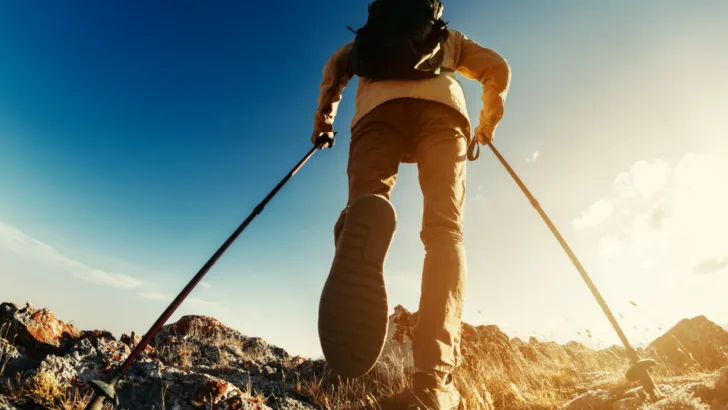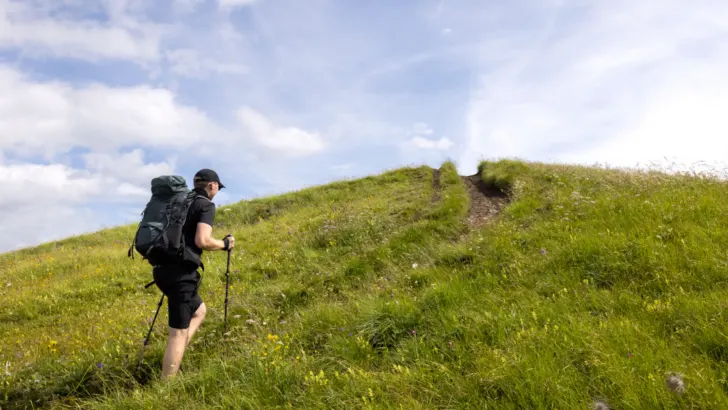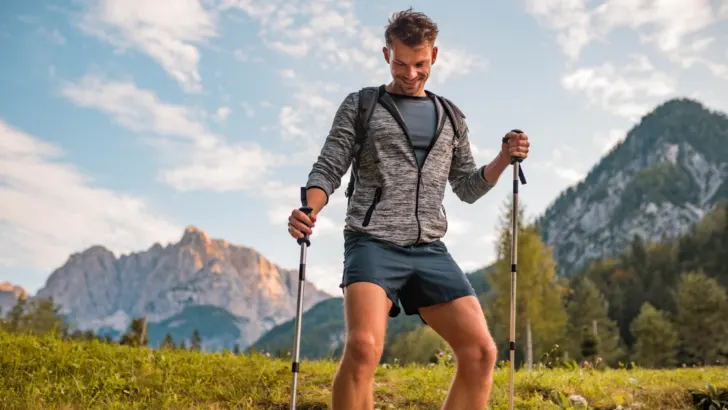How to Use Walking Poles Correctly: Walking poles have been a game-changer for me as a hiker and walker. They offer numerous benefits, such as improved balance, reduced joint stress, and extra support on uneven terrain. However, it’s surprising how many people aren’t aware of the correct way to use walking poles, leading them to miss out on their full potential or even risk injury. That’s why I want to share some personal tips on how to use walking poles correctly, so you can maximize your hiking or walking experience.

Firstly, selecting the right walking poles is crucial. With various options available, ranging from lightweight collapsible poles to sturdier hiking poles, it’s essential to consider factors such as the terrain you’ll be traversing, your experience level, and any physical limitations you may have. Choosing the perfect poles will ensure you have the right tools for the job. Once you’ve found your ideal pair, it’s time to delve into the techniques that will make all the difference in using walking poles effectively and safely. Let’s explore some personal insights and techniques in the following sections.
Key Takeaways
- Choosing the right walking poles is crucial for a safe and effective hiking or walking experience.
- Proper technique, including grip and stride, is essential for getting the most out of your walking poles.
- Regular practice and adjustment can help you improve your technique and get the most benefit from your walking poles.
How to Adjust Walking Poles for Your Height
Adjusting your walking poles to the right height is crucial for maximizing their benefits and avoiding unnecessary strain or discomfort. From my own experience, I’ve learned the importance of getting the height just right. To determine the correct height, start by;
- Standing up straight with your arms relaxed at your sides.
- Gradually adjust the poles until the top of the grip aligns with your wrist level. This ensures that your arms are at a comfortable angle and allows for optimal power transfer and stability.
- Most walking poles are designed to be adjustable, so take advantage of this feature to fine-tune the height according to your specific needs.
By investing a little time in properly adjusting your walking poles, you’ll enhance your overall hiking or walking experience and make every step more enjoyable and efficient.
How to Use Walking Poles for Balance and Stability
Walking poles can help improve your balance and stability while hiking. Make sure to plant the poles firmly on the ground before taking a step. Keep your arms close to your body and use the poles to help distribute your weight evenly. From personal experience, I can attest to the significant role that walking poles play in enhancing balance and stability during hikes. To make the most of these poles, it’s essential to master the proper technique.

As you take each step, firmly plant the poles on the ground, ensuring they make solid contact. By doing so, you establish a strong base of support that aids in maintaining balance on challenging terrain. Keep your arms comfortably close to your body, allowing for natural movement and fluidity. By distributing your weight evenly between the poles, you’ll experience enhanced stability and reduced strain on your legs and joints. Remember, walking poles are not just for show—they are invaluable tools for maintaining balance and conquering uneven ground, allowing you to confidently navigate any trail with ease.
How to Use Walking Poles for Propulsion
Walking poles can also be used to help propel you forward. To use your walking poles for propulsion, plant the poles behind you and push off with your arms as you step forward. This will help you move forward more efficiently and with less effort. Drawing from my personal hiking experiences, I can confidently share the technique of using walking poles for propulsion. W
hen you’re seeking to maximize your forward momentum, strategically position the poles behind you as you take each step. By doing so, you can harness the power of your arms to push off and propel yourself forward. As your foot lands, exert force through the poles, engaging your arm muscles and leveraging their strength to enhance your stride.

This technique not only increases your efficiency but also reduces the strain on your legs, allowing you to cover more ground with less exertion. Embrace the rhythmic coordination of your arms and legs, harmoniously propelling yourself through the terrain. By capitalizing on the potential of your walking poles, you’ll experience a newfound sense of ease and fluidity in your hiking adventures.
How to Use Walking Poles on Different Types of Terrain
Different types of terrain require different techniques for using walking poles. On flat terrain, use your walking poles for balance and stability. On uphill terrain, use your walking poles for propulsion. On downhill terrain, use your walking poles to help slow you down and maintain balance.
When hiking on uneven terrain, it’s a good idea to tie your hiking poles to your backpack. This will help to keep them secure and prevent them from getting lost or damaged. There are a few different ways to tie your hiking poles to your backpack, but one simple method is to use a piece of cord or paracord. Simply tie the cord around the poles and then secure it to the backpack with a knot. This will keep your poles in place and allow you to focus on your hike.

For more information on how to tie your hiking poles to your backpack, check out this article: How to Tie Your Hiking Pole to the Backpack.
As you encounter diverse terrains during your hiking expeditions, it’s essential to adapt your technique for optimal use of walking poles. On flat terrain, leverage your walking poles to enhance your balance and stability. Plant the poles firmly on the ground with each step, allowing them to provide an extra point of contact and support. Engaging your arms and core muscles, maintain a fluid rhythm to promote stability and confidence.
When conquering uphill terrain, your walking poles become valuable allies in propulsion. As you ascend, plant the poles behind you and harness the power of your arms to push off, propelling yourself upward with greater ease. This technique not only aids in distributing the workload across your entire body but also helps you maintain an efficient pace and conquer inclines more effortlessly.
On the other hand, when navigating downhill terrain, your walking poles serve a dual purpose: slowing your descent and maintaining balance. Utilize the poles as an extension of your arms, placing them slightly ahead of your body with each step. The poles provide added stability and act as anchors, helping to prevent slips and fall while minimizing the impact on your joints.
Walking poles can be a valuable tool for unparalleled hiking, but it is important to use them correctly. For example, you should not use poles to push yourself up steep climbs, as this can put unnecessary stress on your joints. Instead, use poles to help you maintain your balance and prevent falls. For more information on unparalleled hiking, read my article ‘What is Unparalleled Hiking: Exploring the Best Trails and Routes‘.
By adapting your technique to the specific demands of each terrain, you can harness the full potential of your walking poles, ensuring a safe, comfortable, and enjoyable hiking experience.
How to Care for Walking Poles
To keep your walking poles in good condition, make sure to clean them after each use. Use a damp cloth to wipe down the poles and dry them thoroughly before storing them. Avoid storing your walking poles in extreme temperatures or direct sunlight.
Taking proper care of your walking poles is crucial to keep them in top shape and ready for your next adventure. After each exhilarating hike, I always make it a point to give my walking poles some TLC. I grab a damp cloth or sponge and carefully wipe down the poles, paying attention to every nook and cranny, from the comfortable handle to the sturdy shaft and the reliable tips.
Once I’ve thoroughly cleaned them, I allow my walking poles to air dry naturally. I find a cool and well-ventilated spot where they can rest and regain their strength. I know that direct sunlight and extreme temperatures can take a toll on the materials, so I make sure to shield them from these harsh conditions.

When it comes to storage, I find a safe and dry place to keep my walking poles. If they are adjustable, I collapse or disassemble them according to the manufacturer’s instructions. This not only saves space but also helps protect the internal mechanisms. To further safeguard them, I often use protective pole sleeves or a dedicated storage bag, ensuring they are shielded from potential impacts and scratches.
To ensure their longevity, I regularly inspect my walking poles for any signs of wear or damage. I give the grips, straps, locking mechanisms, and tips a thorough examination, looking for cracks, fraying, or any signs of loosening. If I notice any issues, I take immediate action to address them. Sometimes, it’s as simple as replacing a worn-out tip or basket, which allows me to extend the life of my beloved walking poles.
By investing a little time and effort into caring for my walking poles, I can count on them to be reliable companions on my hiking journeys. They are always ready to support me, provide stability, and enhance my overall experience in the great outdoors. So, don’t forget to give your walking poles the attention they deserve, and they’ll reward you with countless memorable adventures.
The Benefits of Using Walking Poles for Different Types of Hikers
Walking poles are truly a game-changer, offering a multitude of benefits for hikers of all kinds. As someone who has experienced the remarkable advantages firsthand, I can confidently attest to the positive impact they can have on your hiking journey.
One of the key benefits of using walking poles is their ability to improve balance and stability. Whether you’re navigating rocky trails or crossing uneven terrain, these poles act as reliable companions, providing an extra point of contact with the ground. With each step, you’ll feel a newfound confidence, knowing that your balance is enhanced, and the risk of stumbling or falling is significantly reduced.

For those with joint pain or concerns about the impact on their joints, walking poles are a game-changer. By redistributing the weight and stress from your legs and joints to your upper body, these poles effectively reduce the impact on your knees, ankles, and hips. This gentle and supportive transfer of weight can make a world of difference, allowing you to hike for longer periods without discomfort or strain.
Endurance is another area where walking poles shine. By engaging your upper body muscles, including the arms, shoulders, and core, walking poles help distribute the workload and alleviate fatigue in your lower body. As a result, you can maintain a steady pace, conquer challenging terrains, and extend your hiking adventures with enhanced stamina.
While walking poles offer benefits for hikers of all ages and fitness levels, they are particularly advantageous for older hikers. As we age, balance and stability may become a concern. Walking poles provide an added layer of support and reassurance, empowering older hikers to confidently explore nature’s wonders. Additionally, for individuals with joint pain or conditions such as arthritis, walking poles can be a true lifesaver, allowing them to indulge in their passion for hiking while minimizing discomfort and potential injury.

So, regardless of your age or physical condition, consider incorporating walking poles into your hiking routine. Experience the transformative power they hold to improve your balance, reduce joint impact, and boost your endurance. Let these invaluable companions accompany you on your hiking expeditions, and unlock a world of new possibilities and enjoyment in the great outdoors.
The Different Types of Walking Poles and How to Choose the Right Ones for Your Needs
There are different types of walking poles available, including trekking poles, Nordic walking poles, and hiking staffs. Choose the type of walking pole that best suits your needs and the type of hiking you plan to do.
When it comes to selecting the perfect walking poles, it’s all about finding the ones that suit your personal needs and hiking style. The wide range of options available can be both exciting and overwhelming, but don’t worry—I’m here to guide you through the process.
Trekking poles are a popular choice among hikers like myself due to their versatility. These adjustable poles can be customized to your preferred height and easily collapsed for convenient storage. They’re built to withstand different terrains, from gentle trails to challenging mountainous paths. If you enjoy exploring a variety of landscapes, trekking poles will be your reliable companion.

If you’re looking for a more invigorating full-body workout, Nordic walking poles are worth considering. These poles are designed to enhance upper body movement and engage your arms, providing excellent cardiovascular exercise while you hike. Whether you’re seeking a more intense workout or simply want to spice up your hiking routine, Nordic walking poles can add a new level of excitement and fitness to your adventures.
For those who appreciate a traditional touch, hiking staffs offer a classic and rustic appeal. Crafted from natural materials like wood or lightweight materials, they provide reliable support and stability on moderate terrains. Using a hiking staff can bring a sense of nostalgia and simplicity to your hikes, allowing you to connect with nature in a traditional way.
When making your decision, consider factors such as the terrain you typically encounter, your fitness goals, and your personal preferences. Lightweight materials like carbon fiber or aluminum offer durability without weighing you down. Ergonomic grips and secure locking mechanisms ensure comfort and ease of use during long hikes. By understanding your unique needs and desires, you can find walking poles that perfectly align with your hiking aspirations.

Remember, walking poles are not just accessories—they can significantly enhance your hiking experience. They provide balance, stability, and support, reducing joint impact and increasing endurance. As an avid hiker, I can attest to the transformative power of using the right walking poles. They have become my trusted companions on countless adventures, enabling me to tackle challenging terrains with confidence.
So, take your time to explore the different types of walking poles available, try them out, and see which ones feel like an extension of yourself. Investing in the right pair of walking poles tailored to your needs will elevate your hiking experience, making each step more enjoyable and rewarding. Get ready to embark on new trails, conquer new heights, and create unforgettable memories with the perfect walking poles by your side.
Tips for Using Walking Poles on Difficult Terrain
When facing challenging and rugged terrains during your hikes, proper utilization of walking poles becomes even more crucial. These essential tips will ensure that you navigate difficult terrain with confidence and ease.
- Firm Pole Planting: As you encounter uneven or slippery ground, ensure a secure and firm pole planting technique. Drive the poles into the terrain with a bit more force, allowing them to anchor you as you advance. This firm planting will provide you with the stability needed to tackle the challenging terrain ahead.
- Grip Adjustment: Adapt your grip on the walking poles to suit the specific terrain conditions. For steep ascents, hold the poles a bit higher on the shaft, allowing for more efficient uphill propulsion. On steep descents, adjust your grip lower on the poles, placing your weight on them for improved balance and controlled descent.
- Use Poles for Balance: Walking poles are invaluable for maintaining balance on difficult terrain. Engage your core and use the poles as extensions of your arms to counterbalance your body weight. When navigating rocky or uneven surfaces, plant the poles on either side to create a stable base of support, minimizing the risk of slips or falls.
- Maintain Rhythm: Establish a steady and consistent rhythm with your walking poles to optimize your stability. Coordinate your pole placements with your steps, ensuring that you plant them firmly before taking each stride. This rhythmic synchronization will provide a sense of control and help you maintain a stable and confident pace.
- Adapt to Obstacles: Be prepared to adapt your walking pole technique when encountering obstacles such as fallen logs, streams, or boulders. Utilize your poles to aid in balance and propulsion when stepping over or around obstacles. In the case of water crossings, probe the depth and stability of the stream bed with your poles before proceeding, using them for added support.
By following these tips and practicing proper technique, you’ll harness the full potential of your walking poles when traversing difficult terrain. Remember to remain focused, stay attentive to your surroundings, and always prioritize safety. With each step, you’ll build confidence, conquer challenging trails, and forge unforgettable memories amidst nature’s untamed beauty.
A List of Resources for Further Reading on the Topic of Walking Poles
If you’re interested in learning more about walking poles, there are plenty of resources available online. Check out hiking and outdoor gear websites, as well as hiking forums and blogs, for more information on how to use walking poles correctly.
- https://www.amazon.co.uk/Complete-Guide-Nordic-Walking/dp/1408186578
- https://www.amazon.co.uk/Inglewood-book-Ideal-beginners-Strong-Lightweight-Accessories/dp/B09KM2JT41
- https://www.amazon.co.uk/Complete-Guide-Nordic-Walking/dp/1408186578
Conclusion
Overall, using walking poles can be a great way to improve your hiking experience. With the right technique and equipment, walking poles can help you maintain balance, reduce fatigue, and prevent injury.
Incorporating walking poles into your hiking adventures can greatly enhance your overall experience. By employing the right techniques and selecting suitable equipment, you can unlock a multitude of benefits that will elevate your journey to new heights.
Maintaining Balance: Walking poles act as extensions of your arms, providing an additional point of contact with the ground. This extra support greatly enhances your stability, especially on uneven or challenging terrain. By establishing a firm connection with the trail, you can confidently traverse various landscapes while minimizing the risk of slips and falls.
Reducing Fatigue: The proper use of walking poles helps distribute the workload across your entire body, reducing the strain on your lower limbs. By engaging your upper body muscles, you can alleviate some of the stress placed on your legs and joints, thus reducing fatigue during prolonged hikes. This balanced effort allows you to go further, explore longer trails, and savor the beauty of nature without unnecessary discomfort.
Preventing Injury: Walking poles serve as proactive guardians, providing an added layer of protection against potential injuries. They absorb impact and reduce strain on your knees and ankles, particularly when descending steep slopes or navigating rugged terrain. With each step supported by the poles, you can confidently navigate obstacles and challenging descents, mitigating the risk of accidental twists or sprains.
Enhancing Endurance: By engaging your arms and core muscles, walking poles contribute to an overall increase in your endurance levels. This balanced exertion enables you to maintain a steady pace, regulate your breathing, and sustain your energy throughout your hiking journey. With improved endurance, you can embark on longer hikes, conquer challenging trails, and immerse yourself in the wonders of the great outdoors for extended periods.

Remember, the key to reaping the full benefits of walking poles lies in mastering the proper techniques and utilizing suitable equipment for your unique needs. So, before you embark on your next adventure, take the time to familiarize yourself with the correct use of walking poles. Embrace the stability, reduced fatigue, and injury prevention they offer, and embark on a hiking experience that is not only exhilarating but also safe and rewarding.
Frequently Asked Questions
Q: How can walking poles enhance my hiking experience?
Walking poles offer numerous benefits that can enhance your hiking experience. They improve balance, reduce joint stress, provide extra support on uneven terrain, and increase endurance. By incorporating walking poles into your hikes, you’ll enjoy greater stability, reduced fatigue, and a reduced risk of injury.
Q: What should I consider when choosing walking poles?
When choosing walking poles, consider factors such as the terrain you’ll be hiking on, your experience level, and any physical limitations you may have. Different types of walking poles, such as lightweight collapsible models or sturdier hiking poles, are available. Select the poles that best suit your needs to ensure a safe and comfortable hiking experience.
Q: How do I adjust walking poles to the right height?
To adjust your walking poles to the right height, stand up straight with your arms relaxed at your sides. Gradually adjust the poles until the top of the grip aligns with your wrist level. Most walking poles are adjustable, so make sure to customize the height according to your specific needs.
Q: How do I use walking poles for balance and stability?
To use walking poles for balance and stability, plant the poles firmly on the ground before taking a step. Keep your arms close to your body and use the poles to help distribute your weight evenly. This technique enhances your balance and stability, especially on challenging or uneven terrain.
Q: Can walking poles be used for propulsion?
Yes, walking poles can be used for propulsion. To use your walking poles for propulsion, plant the poles behind you and push off with your arms as you step forward. This technique helps you move forward more efficiently and with less effort, making your hikes more enjoyable and less tiring.
Q: How should I use walking poles on different types of terrain?
Different types of terrain require different techniques for using walking poles. On flat terrain, use your walking poles for balance and stability. On uphill terrain, use them for propulsion. On downhill terrain, use them to help slow you down and maintain balance. By adapting your technique to the specific terrain, you’ll optimize the benefits of walking poles throughout your hike.
Q: How do I care for my walking poles?
To care for your walking poles, clean them after each use by wiping them down with a damp cloth. Dry them thoroughly before storing them in a safe and dry place. Avoid storing them in extreme temperatures or direct sunlight, as this can damage the materials. Regularly inspect your poles for any signs of wear or damage and take appropriate action to maintain their performance and longevity.
Q: What benefits do walking poles offer for different types of hikers?
Walking poles offer a range of benefits for hikers of all types. They improve balance and stability, reduce joint impact, and increase endurance. However, they are particularly beneficial for older hikers or those with joint pain. Walking poles provide additional support and can help alleviate discomfort, allowing hikers to enjoy the outdoors with greater confidence and reduced strain on their bodies.
Q: What are the different types of walking poles, and how do I choose the right ones?
There are different types of walking poles, including trekking poles, Nordic walking poles, and hiking staffs. To choose the right ones for your needs, consider the type of hiking you plan to do and your personal preferences. Research the features and benefits of each type, and select the walking poles that align with your specific requirements and hiking goals.
